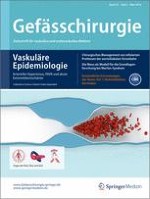Erschienen in:

01.03.2014 | Translationale Forschung
Die Maus als Modell für die Grundlagenforschung bei Marfan-Syndrom
verfasst von:
S. Schwill, P.N. Robinson, P. Seppelt, M. Karck, Prof. Dr. K. Kallenbach
Erschienen in:
Gefässchirurgie
|
Ausgabe 2/2014
Einloggen, um Zugang zu erhalten
Zusammenfassung
Das Marfan-Syndrom ist mit einer Inzidenz von 2–3 Patienten auf 10.000 Geburten eine seltene hereditäre, systemische Bindegewebsstörung. Marfan-Patienten sind durch die Ausbildung von Aneurysmen der Aorta und durch spontane Aortendissektionen gefährdet. Das primäre Ziel bei der Therapie ist die Prävention von lebensbedrohlichen kardiovaskulären Ereignissen. Die Pathogenese der Aortenerkrankung ist nicht abschließend geklärt. Für die Entwicklung neuer Therapieansätze ist eine detaillierte Erforschung der Pathophysiologie vor allem auf molekularer Ebene notwendig. Aus ethischen Überlegungen ist für die Entwicklung experimenteller Therapieansätze ein präklinisches Modell sinnvoll. Hauptanspruch an das Modell ist die Imitation der humanen Pathologie für eine möglichst genaue Translation von Modell zu Mensch. Der vorliegende Beitrag stellt ein Mausmodell des Marfan-Syndroms vor. Die mgR/mgR-Maus zeigt auf makroskopischer und mikroskopischer Ebene phänotypische Manifestationen des Marfan-Syndroms. Damit ermöglicht die mgR/mgR-Maus ein besseres Verständnis der Pathophysiologie und die Entwicklung neuer Therapieansätze zur Behandlung der kardiovaskulären Manifestationen des Marfan-Syndroms.